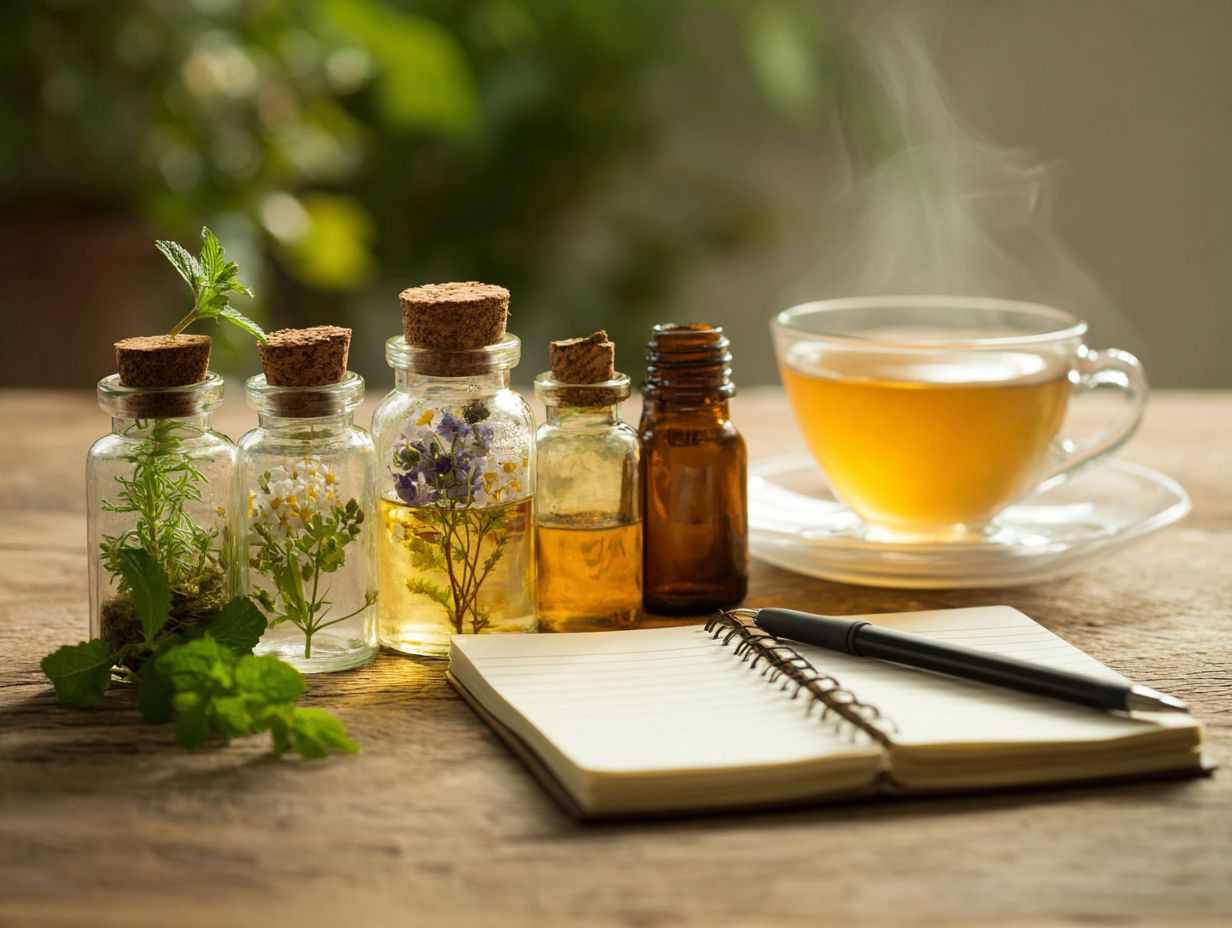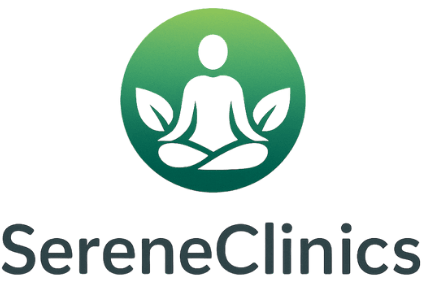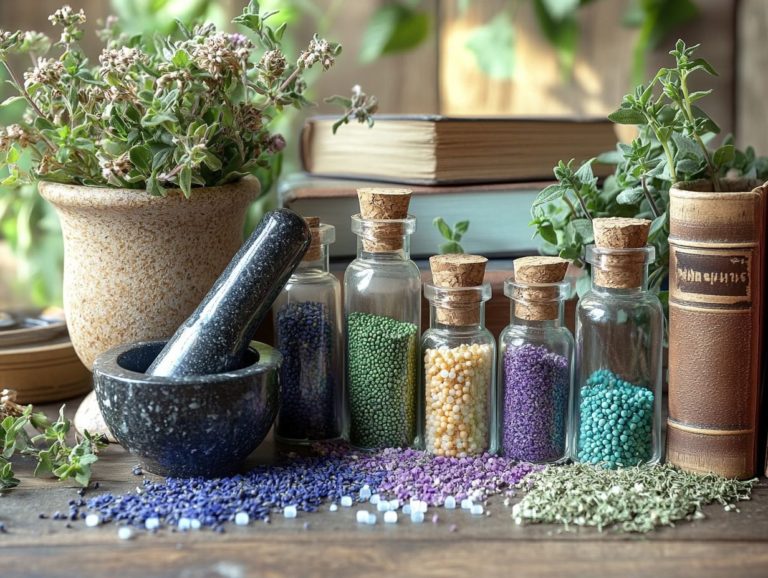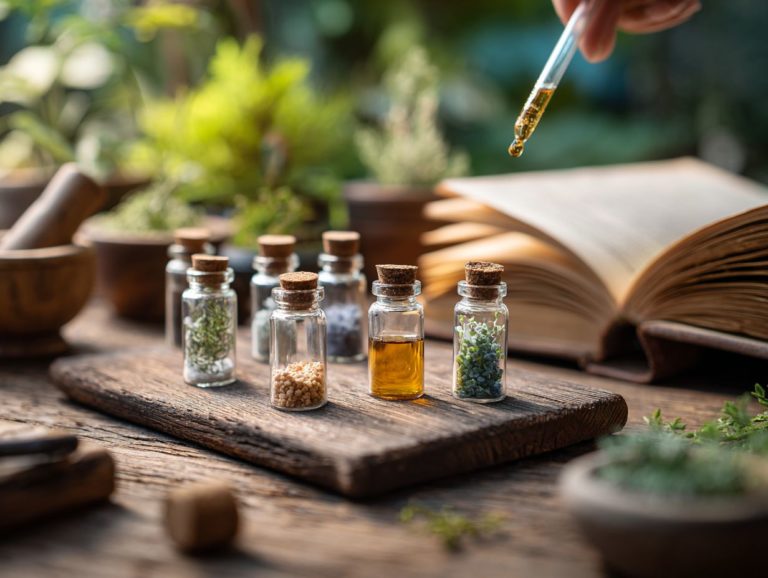Homeopathic Remedies for Colds: Usage Guidelines
Battling the common cold can be frustrating, but homeopathy offers effective remedy options that prioritize your well-being. Homeopathic solutions use main remedies like Arsenicum album and other secondary remedies to treat symptoms as a whole. In this article, we’ll look at how homeopathy can offer natural relief from colds and explain the best ways to use it and how much to take. Learn how to select the right treatments for your situation and improve your well-being quickly!
Key Takeaways:
Contents
- 1 Understanding Colds
- 2 Homeopathic Principles
- 3 Common Homeopathic Remedies for Colds
- 4 Homeopathy Usage Statistics for Colds
- 5 Usage Guidelines
- 6 Considerations and Precautions
- 7 Frequently Asked Questions
- 7.1 1. Can I use homeopathic treatments for colds while taking other medications?
- 7.2 2. Are there any specific guidelines for using homeopathic remedies for colds?
- 7.3 3. Can children and pregnant women use homeopathic remedies for colds?
- 7.4 4. How often should I take homeopathic remedies for colds?
- 7.5 5. Can I use homeopathic remedies for colds to prevent getting sick?
- 7.6 6. Are there any potential side effects of using homeopathic remedies for colds?
Definition of Homeopathy

Homeopathy is defined as a system of medicine that involves treating individuals with highly diluted substances that cause symptoms similar to the condition being treated.
This approach is grounded in two key principles: ‘dilution’ and ‘potentization.’
Dilution is the process where a substance is repeatedly diluted in water or alcohol, often beyond the point where any molecules remain. Afterwards, the mixture is shaken forcefully to improve its healing effects.
For example, in treating allergic rhinitis, a homeopath might use a diluted solution of onion (Allium cepa), which causes similar symptoms. This method encourages the body’s natural ability to heal, considering overall health. According to clinical evidence reviewed by the NHS, homeopathy remains controversial due to differing scientific opinions on its efficacy. For a deeper understanding of these principles and their practical application, explore our [comprehensive guide on homeopathy principles and practices](https://sereneclinics.com/holistic-health/holistic-medicine/homeopathy/homeopathy-principles-practices/).
History of Homeopathic Practices
Homeopathy started in the late 18th century. Samuel Hahnemann created it as a natural method for healing.
Hahnemann’s foundational text, the ‘Organon of Medicine,’ published in 1810, outlined core principles such as ‘like cures like’ and the importance of individual treatment.
By the mid-19th century, homeopathy gained traction in Europe, with notable figures like Hahnemann influencing practitioners and establishing clinics.
In India, homeopathy expanded significantly, leading to the establishment of dedicated homeopathic schools by the late 19th century.
Today, India boasts a vast network of practitioners and institutions, reinforcing homeopathy’s global presence and acceptance, particularly in Europe and Asia. This growth is highlighted in a paper published by the Royal Society which examines the extensive history and influence of homeopathy in the far East.
Understanding Colds
The common cold is mostly caused by viruses and consists of a collection of symptoms that vary in duration and intensity. However, addressing these symptoms can sometimes involve alternative approaches, such as herbal medicine, which is discussed in the context of holistic health (our parenthetical guide to herbal medicine in holistic health covers benefits and considerations).
Common Symptoms of a Cold
Typical symptoms of a cold include nasal discharge, body aches, and occasional flu-like symptoms such as a sore throat or fatigue.
These symptoms usually appear slowly and can differ in how serious they are.
For nasal discharge, expect it to start clear and become thicker or yellowish over time. Body aches are usually mild but can cause tiredness, so getting enough rest is important for getting better. Sore throats can stem from postnasal drip, resulting in discomfort.
To alleviate symptoms, consider over-the-counter remedies like:
- ibuprofen for pain relief,
- saline nasal sprays for congestion, and
- throat lozenges to soothe irritation.
Drinking enough water and sleeping well are important for recovery.
Causes of Colds
Colds are primarily caused by viral infections, with rhinoviruses accounting for about 30-50% of cases according to the CDC.
Other significant viruses include coronaviruses and adenoviruses, which also contribute to respiratory illnesses. Transmission typically occurs through respiratory droplets when an infected person sneezes or coughs.
Touching contaminated surfaces and then touching your face is another common route. A 2020 study found that children are particularly susceptible, experiencing up to 6-8 colds annually.
To reduce your risk, practice good hygiene by washing hands regularly with soap for at least 20 seconds and avoid close contact with sick individuals. According to guidelines from the CDC, these precautions can significantly minimize the spread of respiratory viruses.
Duration and Impact
Typically, a cold lasts between 7 to 10 days, significantly impacting daily activities and productivity.
During this time, symptoms such as coughing, sneezing, and fatigue can lead to missed workdays, with studies indicating an average of 2-3 days off for affected individuals. This interrupts people’s schedules and impacts the economy, leading businesses to lose billions each year because of lower productivity.
To help with this, think about using preventative measures like hand sanitizers and vitamin C supplements, which can help strengthen your immune system. Getting enough sleep, eating well, and exercising regularly can help build resistance to colds.
Homeopathic Principles
Homeopathy is based on certain principles, especially the idea that like cures like and the process of strengthening treatments, which guide individualized care. For those interested in exploring these concepts further, the principles of homeopathy are discussed in detail, including their evidence-based integration, in our recent analysis of homeopathy principles and practices.
Law of Similars
The law of similars posits that a substance causing symptoms in a healthy person can be used to treat similar symptoms in an ill person.
For instance, if a person has hay fever with sneezing and a runny nose, a homeopath might recommend a small dose of Allium cepa, which is made from onions, because onions can cause these symptoms in someone who is well.
For anxiety manifested through restlessness, a remedy such as Coffea cruda, made from coffee, might be effective as it can produce heightened states of agitation.
Homeopaths often make treatments according to a patient’s specific symptoms, considering both the sickness and their general health.
Potentization Process

Potentization is the process of making a substance more effective for healing by diluting and shaking it repeatedly, which also makes it less harmful.
This process involves several steps.
- First, a specific quantity of the substance is diluted in a solvent, often alcohol or water, to achieve the desired concentration.
- For instance, a common 30C dilution involves one part of the original substance to 99 parts of diluent, done 30 times.
- Mixing the diluted solution thoroughly activates its healing properties.
- Using tools like a homeopathic potentizer can make the process easier, giving reliable results.
- Learning how to properly increase the strength of remedies improves their effectiveness, which is very important for practitioners.
Individualized Treatment
Individualized treatment in homeopathy means tailoring remedies to each patient’s unique symptoms and constitution.
Experts hold detailed meetings where they examine physical symptoms and consider emotional and lifestyle aspects.
For example, a patient suffering from chronic migraines may be treated with a remedy like Bryonia, especially if symptoms worsen with movement, while another might benefit from Nux Vomica if their headaches stem from stress and irritability.
Healthcare professionals often use detailed questionnaires or software that monitors patient responses over time, which helps in modifying treatment when necessary.
The personalized method resulted in successes, like a situation where a specific treatment plan greatly reduced a patient’s serious anxiety in just a few weeks.
Common Homeopathic Remedies for Colds
Different homeopathic treatments are frequently used for cold symptoms, each focusing on particular signs of the illness.
Homeopathy Usage Statistics for Colds
Homeopathy Usage Statistics for Colds
Homeopathy Usage: Global Usage
The Homeopathy Usage Statistics for Colds highlights the adoption of homeopathic remedies among adults in Europe, particularly focusing on Italy and Germany. This data shows how often people in these countries choose alternative medicine to treat colds.
Homeopathy Usage data reveals that 8.2% of adults in Italy opt for homeopathic solutions when dealing with colds. This suggests a moderate acceptance of homeopathy as part of health management strategies, influenced by cultural preferences and available healthcare options.
In contrast, 14.8% of adults in Germany use homeopathy for colds, indicating a higher acceptance rate compared to Italy. Germany’s long-standing tradition of integrating alternative medicine into healthcare practices might contribute to this increased usage. This also reflects a broader acceptance of homeopathy as a complementary approach to conventional medicine in Germany.
- Implications: The data suggests varying degrees of trust and reliance on homeopathy across different nations. It highlights how important it is to know cultural and regional differences when looking at the market for homeopathic products.
- Potential Growth: The statistics could guide healthcare providers and marketers in tailoring their approaches to regions with higher acceptance rates, like Germany, while identifying opportunities to increase awareness and usage in countries with lower rates, such as Italy.
In summary, the Homeopathy Usage Statistics for Colds emphasizes the need to consider regional preferences in healthcare. Knowing these differences can help stakeholders create strategies that match how consumers act and what they like in various markets.
Allium Cepa
Allium Cepa, made from red onion, is particularly effective for treating profuse nasal discharge and eye irritation associated with colds.
The typical dosage for adults is 30c potency, taken thrice daily, particularly when symptoms are most pronounced. For children, a 6c potency taken twice daily can be beneficial.
Administration can be through sublingual tablets, which dissolve easily for quick absorption. Allium Cepa might reduce allergy symptoms.
Check with a doctor before trying any new treatment to make sure it’s right for your health issue.
Belladonna
Belladonna is often recommended for high fevers and intense pain, making it a common choice for sudden colds.
It is particularly effective in reducing symptoms like throbbing pain and muscle spasms.
For adults, typically take 0.15 to 0.6 grams of the extract every 6-8 hours if needed. Be aware of possible side effects like dizziness or blurred vision.
Precautions should include avoiding use in cases of glaucoma or prostate enlargement. Always consult a healthcare professional before starting treatment, especially if you’re pregnant or on other medications, to prevent potential interactions.
Gelsemium
Gelsemium is indicated for flu-like symptoms, particularly when accompanied by body aches and fatigue.
This homeopathic remedy is typically used in a 30C potency.
Clinical observations suggest that Gelsemium is most effective when symptoms include chills, trembling, and a sensation of heaviness. Always speak with a doctor for specific advice, especially if symptoms persist beyond a few days.
Using Gelsemium along with drinking plenty of water and getting rest can help you recover faster when you’re sick.
Nux Vomica

Nux Vomica is commonly used for colds that arise after overindulgence, addressing symptoms like irritability and digestive discomfort.
For optimal effectiveness, Nux Vomica is typically administered in a 30C potency, taken three times daily until symptoms improve. It’s particularly beneficial in cases where patients experience nausea, a feeling of fullness, or headaches exacerbated by indulgent foods or alcohol.
Using Nux Vomica along with changes like drinking enough water, reducing fatty foods, and getting enough rest can improve recovery. Always consult a doctor for personal advice, particularly if symptoms persist for more than a few days.
Arsenicum Album
Arsenicum Album is recommended for cold symptoms that include nervousness and restlessness, particularly with a slight fever.
It is particularly effective for symptoms such as a runny nose, sneezing, chilliness, and digestive disturbances. You can usually take a 30C dose every 4 to 6 hours until you improve.
For those feeling increased anxiety, using Arsenicum Album along with relaxation techniques-such as deep breathing or gentle yoga-can help increase comfort. Monitoring symptoms closely is essential; if they persist or worsen, consulting a healthcare professional is advisable.
This remedy provides a complete method for handling both emotional and physical symptoms.
Usage Guidelines
Following the correct instructions for homeopathic remedies is important to make sure they work well and are safe for treating colds. Implement this by following the guidelines in our tips on using various homeopathic products.
Dosage Recommendations
Dosage instructions for homeopathic treatments can differ depending on the person’s age, how serious the symptoms are, and their specific health issues.
For infants, a typical dosage might be 6C to 30C, administered once or twice a day.
For children between the ages of 2 and 12, the doses typically increase to 30C or 200C, taken 1 to 3 times a day depending on the severity of the condition.
Adults usually start with 30C or higher, adjusting frequency based on symptom intensity.
Resources like “The Complete Homeopathy Handbook” provide extensive guidance on specific remedies and dosage adjustments according to individual needs. Always consult a homeopathic specialist for advice specific to your needs.
Frequency of Administration
The frequency of administering homeopathic remedies can significantly influence their effectiveness and patient outcomes.
People often use homeopathic treatments multiple times a day. For unexpected symptoms, take doses every 15 to 30 minutes. As the symptoms get better, the frequency is reduced to 2-3 times a day.
For chronic issues, a weekly dose might suffice once stability is achieved. Always assess symptom changes; if improvement occurs, consider reducing the frequency to avoid overdosage.
Using tools like a dosing chart can help track administration, ensuring consistency. Individual responses vary, so maintaining open communication with a healthcare provider is essential.
Signs to Discontinue Use
It’s important to notice when to stop using homeopathic treatments to prevent possible side effects.
Specific symptoms warranting discontinuation include a worsening of the condition, appearance of new, unexplained symptoms, or a lack of improvement after a reasonable trial period (typically two to three weeks). If you notice any of these signs, it’s advisable to consult a healthcare professional.
In some cases, transitioning to conventional treatments like over-the-counter medications or prescribed therapies might be necessary. Always talk to your healthcare provider about other options that suit your health needs.
Considerations and Precautions
When using homeopathic remedies for colds, it is important to pay attention to safety measures and effectiveness. For those interested in understanding the foundational aspects of this approach, you might explore how these remedies align with homeopathy principles and practices.
Consulting a Homeopath
Talking to an experienced homeopath can provide you with specific advice for treating cold symptoms.
During a consultation, expect a detailed talk about your symptoms, lifestyle, and general health, which helps the homeopath find the best treatments.
To find a qualified practitioner, check credentials with organizations like the Council for Homeopathic Certification (CHC) or the National Center for Homeopathy (NCH).
Find doctors who focus on short-term illnesses like colds, as their skills will make the treatment work better. Focus on those who have good reviews or are recommended by reliable people for a good consulting experience.
Possible Side Effects

While generally considered safe, homeopathic remedies can occasionally lead to mild side effects that users should be aware of.
Common side effects include digestive upset, headaches, or skin rashes. For example, using a remedy with a lot of arnica may occasionally lead to stomach problems.
Users should monitor their reactions closely and keep a journal of any unusual symptoms. If reactions occur, report these to a healthcare professional, as adjusting dosage or switching remedies might be necessary.
Getting remedies from trusted sources guarantees good quality and dependability, which can lower the chance of harmful side effects.
Interactions with Conventional Medicine
Interactions between homeopathic remedies and conventional medicines can occur, necessitating careful consideration and professional advice.
Consult your healthcare provider about any homeopathic treatments you are considering. For instance, if you’re using St. John’s Wort, which may reduce the effectiveness of antidepressants, inform your doctor.
Remedies like Arnica, often used for pain relief, might affect bleeding tendencies when combined with blood thinners. Always maintain transparency by providing a complete list of your current medications and supplements.
This forward-thinking method leads to safer treatment plans and reduces unexpected interactions.
Frequently Asked Questions
1. Can I use homeopathic treatments for colds while taking other medications?
Yes, homeopathic remedies can be safely used alongside other medications. Before starting any new treatment, talk to a healthcare professional to check for any possible interactions.
2. Are there any specific guidelines for using homeopathic remedies for colds?
Yes, it is recommended to take homeopathic remedies for colds at the first sign of symptoms and to continue using them until symptoms subside. It is also important to follow the recommended dosage instructions on the product packaging.
3. Can children and pregnant women use homeopathic remedies for colds?
Yes, homeopathic remedies are generally considered safe for children and pregnant women. It’s always a good idea to talk to a doctor before using it, especially if you are pregnant.
4. How often should I take homeopathic remedies for colds?
This depends on how bad your symptoms are and the remedy you are using. It’s usually suggested to take the remedy every 2-4 hours until you feel better, then take it less often as your symptoms go away.
5. Can I use homeopathic remedies for colds to prevent getting sick?
Homeopathic remedies are not typically used as a preventative measure, but rather to treat symptoms once they have already appeared. However, some people may find them useful for prevention. As always, consult with a healthcare professional before use.
6. Are there any potential side effects of using homeopathic remedies for colds?
Homeopathic remedies are generally considered safe and have minimal side effects. However, like any medicine, there is always a chance of an allergic reaction. If you experience any adverse effects, stop using the remedy and consult with a healthcare professional.

Sheetal Sharda has a background in CS. She got an interest in Holistic living back in 2018, and has since started exploring more into Naturapathy, Holistic Living, Yoga, and more. She got inspired to start SereneClinics to help people find reliable centers across the world.





